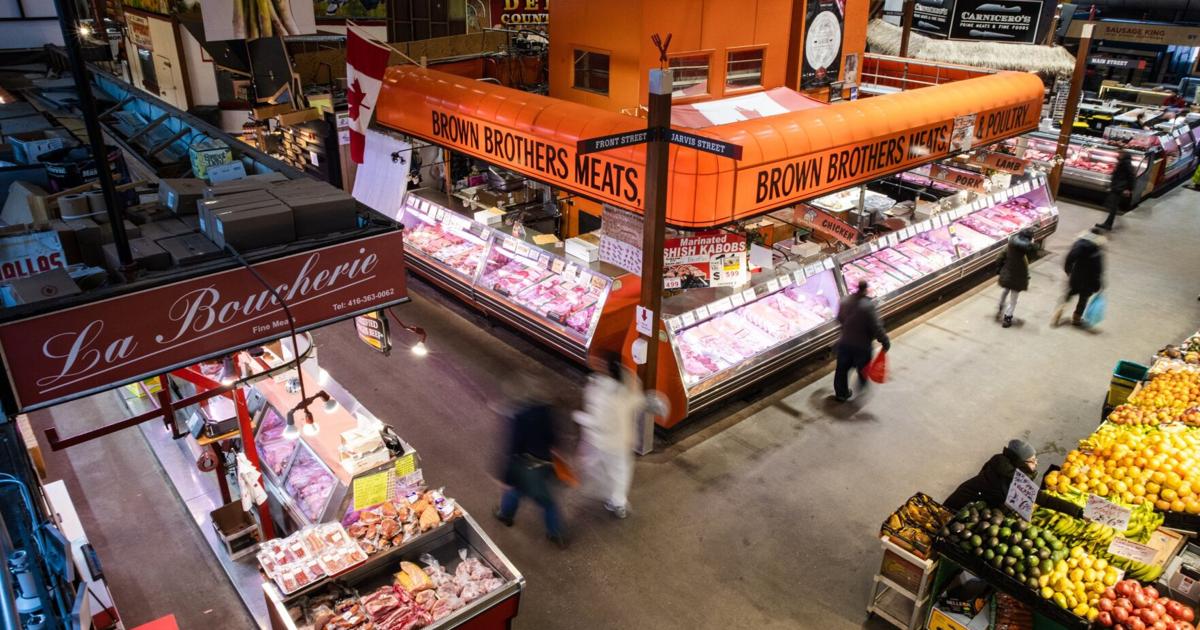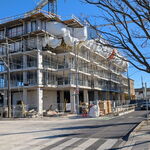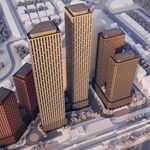taal
Senior Member
Did the flatiron building sell for the same price it did 13+ years ago?
“$200,000 more than the $15.2-million that the previous owner paid for the building in 2011.”Did the flatiron building sell for the same price it did 13+ years ago?
The inside is surprisingly 'boring' - it was clearly gutted at some time so few if any historic features remain and the parts of the inside I saw about 5 years ago were certainly not Class A space - an iconic exterior but .....Paywall unfortunately, but I can extrapolate the details from the snippet above. I'm still a little surprised - clearly it's a non development site so that's a factor but it's such a prime and iconic location. Maybe if the building needs a lot of maintenance though that could explain it.

What they're really afraid of, it seems, is that the city is attracting more and more people who are coming to watch the market in action, not be part of the action. The problem with that is, if the market tries too hard to cater to tourists, it risks becoming another fancy food court. And the shops that have been the core of the market for centuries — the butchers, grocers and fish mongers — will stop making sense.
Interesting article on the challenges that butchers and grocers are facing as St. Lawrence Market's customer-base moves away from locals and towards tourists.

Longtime St. Lawrence Market shops are closing. Vendors fear its future is at risk. Are tourists to blame?
Vendors say extended hours have attracted more tourists — but tourists tend to watch the action rather than loading up on meat, fish and produce. "This is a market, notwww.thestar.com
There are similar issues in markets in Europe, where social media foodies and influencers are turning once diverse markets into Insta-bait food courts. See Barcelona's famous market:
https://roadsandkingdoms.com/2018/the-battle-for-the-boqueria/
My wife and I have visited probably dozens of markets around Europe, particularly in Spain, Portugal and Greece. There's definitely a wide range. Some are clear tourist traps, usually architecturally pretty but essentially now just souvenir shops, with few locals shopping and English signage on everything. I think they are about as exciting as an airport terminal duty free shop. Outside the tourist core there are sometimes other markets that are a bit scruffier and geared towards locals. If I feel out of place and I don't recognize many things on sale it's a much more interesting experience, though I realize I'm the tourist probably ruining the place. I try to be discreet in my photo taking but I don't fool anyone. And it's true, when we're on vacation we don't buy a lot of raw meat or fish... it doesn't make any sense to do so. At most we might eat lunch at a stall, or buy a jar of supposedly-local honey or olive oil to bring home for the friend who waters our plants.Interesting article on the challenges that butchers and grocers are facing as St. Lawrence Market's customer-base moves away from locals and towards tourists.
This is an excellent post. (Or, to put it another way, I agree with it!) Though I understand that the updated hours are a problem for family-run places, the purpose of a retail establishment is to serve customers and most customers are FAR better served now than in the past. Like @CityPainter we seldom have shopped there on Saturdays for ages as the crowds are 'in the way' and the merchants are too busy to chat, weekday shopping is far more 'social'. The City has plans to 'fix up' the lower level but these seem to be on hold - partly due to the covid delays that affected all such projects but they do need to get on with it and open up the west side to Market Street to take advantage of it now (supposedly) being a pedestrian street all year. We buy 99% of our vegetables at the Markets (regular and Farmers) as the quality is SO much better and the prices the same or, often, lower than No Frills and Metro. We used to buy most of our bread there too but the Bimbo purchase of Stonemill did not help their quality or value or increase the range of breads available - which actually declined. (It is actually odd that a large multi-national was able to keep on having a - large - stall there at all.)My wife and I have visited probably dozens of markets around Europe, particularly in Spain, Portugal and Greece. There's definitely a wide range. Some are clear tourist traps, usually architecturally pretty but essentially now just souvenir shops, with few locals shopping and English signage on everything. I they are about as exciting as an airport terminal duty free. Outside the tourist core there are sometimes other markets that are a bit scruffier and geared towards locals. If I feel out of place and I don't recognize many things on sale it's a much more interesting experience, though I realize I'm the tourist probably ruining the place. I try to be discreet in my photo taking but I don't fool anyone. And it's true, when we're on vacation we don't buy a lot of raw meat or fish... it doesn't make any sense to do so. At most we might eat lunch at a stall, or buy a jar of supposedly-local honey or olive oil to bring home for the friend who waters our plants.
But I'm not convinced that this is the particular fate of the St. Lawrence Market, or that the extended hours are the culprit. Many vendors have fought the hour changes tooth-and-nail. Now they are blaming the extended hours for the place being busier which seems a bit... strange. Shouldn't longer hours spread out the foot traffic, not concentrate it? The busiest times remain the same. We've lived nearby for over 20 years and Saturdays have always been a no-go for us due to the crowds of slow-walking gawkers that make serious shopping impossible. If we do need something there on a Saturday we plan our entry and exit with military precision to minimize the distance we need to fight through the crowds. When they opened Sundays, I found the crowds busy, but less insane than Saturdays. The hour extensions later into the evenings really favour locals more: it's not tourists showing up at 6pm, it's locals on their way home from work. If anything we go more often. Friday evenings are the best time to go, it's quiet and they're fully stocked for the weekend.
We were regulars at Whitehouse. They had very good quality meat. But honestly, I didn't love shopping there. The service could be friendly but more often was gruff. I was lectured for not standing in the "right spot" a few times. The display cases were really high, cutting across at my eye level and making it hard to converse with the sellers. And, frankly, it was very expensive, even for basic ingredients (we definitely weren't buying kangaroo meat.) La Boucherie has always been our fallback, now we just go there more often. There are also lot of other butchers in the market, all with pretty much interchangeable products, and it's hard to imagine that they don't simply steal business from each other.
Most of the market has changed surprisingly little over the past two decades. Stack'd is the really only new major vendor I can recall in years. The new flower shop by the main entrance looks nice. The market installed slightly better seating after the pandemic, but it's not exactly been transformed into Eataly. The lower floor still maintains the prison-like vibe of its former use, despite years of talk about refurbishments. There's the exact same mix of veggie and takeout places, all of which have always been busy. Rube died but his rice shop has remained essentially frozen in time. Everything remains conspicuously European-centric, aside from the Chinese-Canadian takeout, a perfunctory sushi roll spot, and a single "Mexican" place with very pricey specialty products. If you ask about cuts of meat needed for an interesting Asian or Mexican recipe you saw on America's Test Kitchen the butchers will look at you blankly.
If anything's changing for the worse, I don't think the hours are to blame. It's outside forces. Work-from home probably hurt them, with fewer well-paid office workers theoretically stopping by on the way home from the finance district, though as a previous poster said, fewer people cook elaborate meals at home every day than they did a few decades ago.
People with money to spend now have many more quality food options, with Whole Foods and Farm Boys and similar supermarkets a short distance away downtown, as well as in every suburb. In the city there are options like Eataly and McEwan's. Even Union Station is becoming a competitor to the St. Lawrence Market now, with lots of upscale food vendors. And I notice that these are much more diverse and representative of modern Toronto, selling trendy Japanese and Korean foods and imported products.
For those with less money to spend, food prices are a big problem for many people right now. Aside from some of the veggie sellers, most food at the market is priced far above what you can get at Metro or No Frills, both within walking distance. A shop called "Lively Life" on the lower floor sells canned products for $6 that you can buy at Metro, across the street, for $2.49. I don't think price-conscious shoppers see the market as a place for them.
There's also the perpetual complaint about parking, and even if this is more about perception than reality, it probably hurts. There hasn't been a big lot next to the market since the 1980s redevelopment of the neighborhood, but many of the smaller pay lots in surrounding streets have steadily vanished due to condo development. There's still a big garage at the south end of Church St, but many people don't know about it. In general, the gridlock around Front and Jarvis makes getting through that area by car a nightmare, so I don't imagine it makes many want to stop and linger. Being a pedestrian is only marginally better. These are challenges that extend beyond the market, but they no doubt affect it.
I don't know what the solution is -- the market needs to change an adapt, but I'd hate to see it become a tourist food court. On the other hand, stubbornly catering to the outdated living, eating and shopping habits of 1982 is not a road to success either.
As we have discussed here before, the painting of utility locates does not mean that the sidewalk or road will be opened up. They often paint them to guide them as they pull cables through existing conduits that bend and branch. Not that I say there will be no excavation but it is not (yet) clear!What’s the over/under for sidewalk cuts post project completion? Oh wait, this is the second cut. SW corner of Scott and Wellington was a few months ago.
Any guess as to what‘s planned For these two work areas?
1. North side of Wellington at Scott
2. Wellington St. north side around CRAIB at 42 Wellington St. E. Or Pravda 50 Wellingon St. E
View attachment 540586
View attachment 540592
View attachment 540587
Paint starts West of scott looking west on wellington.
View attachment 540588
Looking west on wellington at scott
View attachment 540589
Looking east on wellington east of scott.
View attachment 540590
Scott st looking north
View attachment 540591
It looks to me like this will turn out to be another stint as an abandoned building.Today I noticed crews installing wooden hoarding along both sides of the former La Maquette building, next to the sculpture garden.
There are no building permits in the city database for this address yet: is this the start of a renovation for a new tenant, or the start of a long stint as an abandoned building, I wonder?
View attachment 535213




